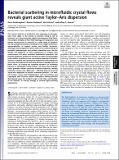| dc.contributor.author | Dehkharghani, Amin | |
| dc.contributor.author | Waisbord, Nicolas | |
| dc.contributor.author | Dunkel, Joern | |
| dc.contributor.author | Guasto, Jeffrey S. | |
| dc.date.accessioned | 2019-12-20T15:11:53Z | |
| dc.date.available | 2019-12-20T15:11:53Z | |
| dc.date.issued | 2019-05 | |
| dc.date.submitted | 2018-11 | |
| dc.identifier.issn | 0027-8424 | |
| dc.identifier.issn | 1091-6490 | |
| dc.identifier.uri | https://hdl.handle.net/1721.1/123314 | |
| dc.description.abstract | The natural habitats of planktonic and swimming microorganisms, from algae in the oceans to bacteria living in soil or intestines, are characterized by highly heterogeneous fluid flows. The complex interplay of flow-field topology, self-propulsion, and porous microstructure is essential to a wide range of biophysical and ecological processes, including marine oxygen production, remineralization of organic matter, and biofilm formation. Although much progress has been made in the understanding of microbial hydrodynamics and surface interactions over the last decade, the dispersion of active suspensions in complex flow environments still poses unsolved fundamental questions that preclude predictive models for microbial transport and spreading under realistic conditions. Here, we combine experiments and simulations to identify the key physical mechanisms and scaling laws governing the dispersal of swimming bacteria in idealized porous media flows. By tracing the scattering dynamics of swimming bacteria in microfluidic crystal lattices, we show that hydrodynamic gradients hinder transverse bacterial dispersion, thereby enhancing stream-wise dispersion ∼100-fold beyond canonical Taylor–Aris dispersion of passive Brownian particles. Our analysis further reveals that hydrodynamic cell reorientation and Lagrangian flow structure induce filamentous density patterns that depend upon the incident angle of the flow and disorder of the medium, in striking analogy to classical light-scattering experiments. | en_US |
| dc.description.sponsorship | National Science Foundation (Award CBET- 1510768) | en_US |
| dc.language.iso | en | |
| dc.publisher | Proceedings of the National Academy of Sciences | en_US |
| dc.relation.isversionof | http://dx.doi.org/10.1073/pnas.1819613116 | en_US |
| dc.rights | Article is made available in accordance with the publisher's policy and may be subject to US copyright law. Please refer to the publisher's site for terms of use. | en_US |
| dc.source | PNAS | en_US |
| dc.title | Bacterial scattering in microfluidic crystal flows reveals giant active Taylor–Aris dispersion | en_US |
| dc.type | Article | en_US |
| dc.identifier.citation | Dehkharghani, Amin et al. "Bacterial scattering in microfluidic crystal flows reveals giant active Taylor–Aris dispersion." Proceedings of the National Academy of Sciences 116, 23 (May 2019): 11119–11124 © 2019 National Academy of Sciences | en_US |
| dc.contributor.department | Massachusetts Institute of Technology. Department of Mathematics | en_US |
| dc.relation.journal | Proceedings of the National Academy of Sciences | en_US |
| dc.eprint.version | Final published version | en_US |
| dc.type.uri | http://purl.org/eprint/type/JournalArticle | en_US |
| eprint.status | http://purl.org/eprint/status/PeerReviewed | en_US |
| dc.date.updated | 2019-11-12T15:39:47Z | |
| dspace.date.submission | 2019-11-12T15:39:57Z | |
| mit.journal.volume | 116 | en_US |
| mit.journal.issue | 23 | en_US |
